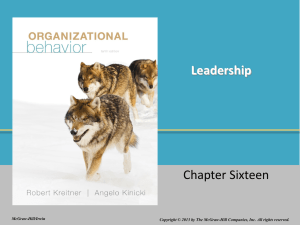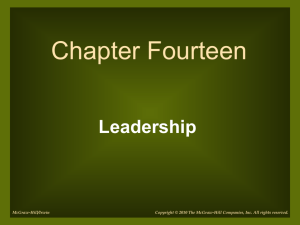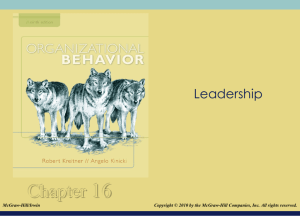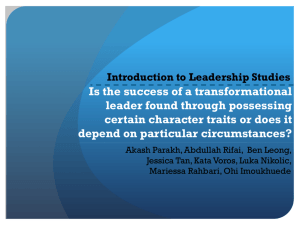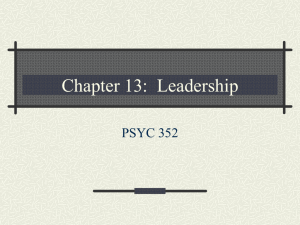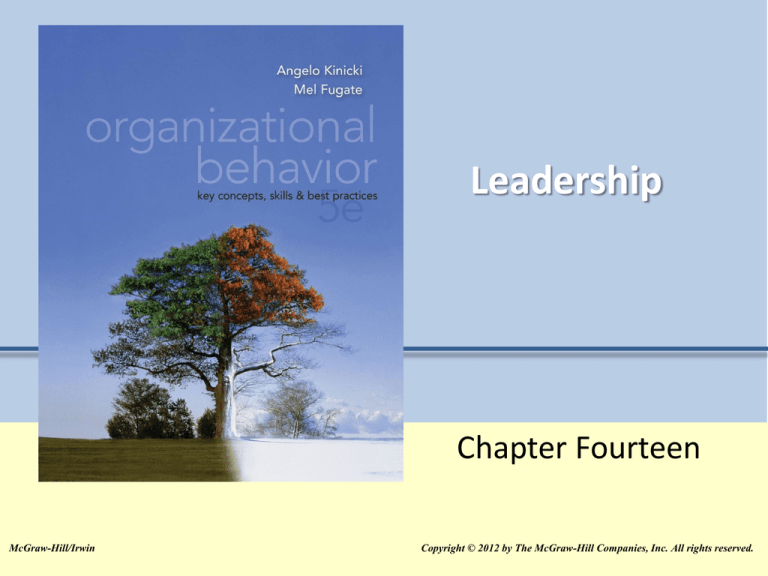
Leadership
Chapter Fourteen
McGraw-Hill/Irwin
© 2012 The McGraw-Hill Companies, Inc. All rights reserved.
Copyright © 2012 by The McGraw-Hill Companies, Inc. All rights reserved.
After reading the material in this chapter,
you should be able to:
LO14.1 Review trait theory research, and discuss
the takeaways from both the trait and
behavioral styles theories of leadership.
LO14.2 Explain, according to Fiedler’s contingency
model, how leadership style interacts with
situational control, and discuss the takeaways
from this model
LO14.3 Discuss House’s revised path-goal theory
and it’s practical takeaways.
14-2
After reading the material in this chapter,
you should be able to:
LO14.4 Describe the difference between transactional
and transformational leadership and discuss how
transformational leadership transforms followers
and work groups.
LO14.5 Explain the leader-member exchange (LMX)
model of leadership and the concept of shared
leadership.
LO14.6 Review the principles of servant leadership.
LO14.7 Describe the follower’s role in the leadership
process
14-3
What Does Leadership Involve?
Leadership
“a social influence process in which the leader
seeks the voluntary participation of
subordinates in an effort to reach organizational
goals”
14-4
Trait Theory
Leader trait
physical or personality characteristic that can
be used to differentiate leaders from followers.
14-5
What Traits Are Possessed by
Effective Leaders?
Intelligence
Dominance
Level of
energy and
activity
Selfconfidence
Task-relevant
knowledge
14-6
What Traits Are Possessed by
Effective Leaders?
Implicit leadership
theory
based on the idea
that people have
beliefs about how
leaders should
behave and what
they should do for
their followers.
Leadership
prototype
mental
representations of
the traits and
behaviors
possessed by
leaders.
14-7
What Traits Are Possessed by
Bad Leaders?
Incompetent
Rigid
Intemperate
Callous
Corrupt
Insular
Evil
14-8
Do Women and Men Display the
Same Leadership Traits?
Men and women were seen as displaying
more task and social leadership,
respectively
Women used a more democratic or
participative style than men and men used a
more autocratic and directive style than
women
14-9
What Are the Takeaways from
Trait Theory?
First, organizations may want to include
personality and trait assessments into their
selection and promotion processes.
Second, management development
programs can be used to build a pipeline of
leadership talent.
14-10
Key Positive Leadership Traits
14-11
Behavioral Styles Theory
The Ohio State Studies identified two
critical dimensions of leader behavior.
Consideration: creating mutual respect and
trust with followers.
Initiating structure: organizing and defining
what group members should be doing.
14-12
Question?
Allen thrives on organizing and defining
what group members should be doing to
maximize output. According to the Ohio
State researchers, Allen is exhibiting which
of these behaviors?
A.Initiating structure
B.Concern for people
C.Relationship-motivated
D.Consideration
14-13
Takeaways from Behavioral Styles
Theory
Leader behaviors can be systematically
improved and developed.
There is no one best style of leadership.
The effectiveness of a particular leadership
style depends on the situation at hand.
14-14
Situational Theories
Situational theories
propose that the effectiveness of a particular
style of leader behavior depends on the
situation.
14-15
Fiedler’s Contingency Model
The performance of a leader depends on two
interrelated factors:
1. The degree to which the situation gives
the leader control and influence
2. The leader’s basic motivation
14-16
Fiedler’s Contingency Model
Situational control
refers to the amount of control and influence
the leader has in his immediate work
environment
14-17
Three Dimensions of Situational
Control
Leader-member relations
the extent to which the leader has the support, loyalty,
and trust of the work group
Task structure
concerned with the amount of structure contained
within tasks performed by the work group
Position power
the degree to which the leader has formal power to
reward, punish, or otherwise obtain compliance from
employees
14-18
Representation of
Fiedler’s Contingency Model
14-19
Question?
Kimberly is a task-motivated leader.
According to Fiedler's work, Kimberly would
not be effective under which conditions?
A.Situations of high control
B.Conditions of low control
C.Conditions of achievement-orientation
D.Conditions of moderate control
14-20
Path-Goal Theory
Describes how leadership effectiveness is
influenced by the interaction between four
leadership styles – directive, supportive,
participative, achievement-oriented
Contingency factors
Situational variables that cause one style of
leadership to be more effective than another
14-21
A Reformulated Theory
Three key changes:
1. Leadership is more complex and involves
a greater variety of leader behavior.
2. The role of intrinsic motivation and
empowerment in influencing leadership
effectiveness
3. Shared leadership
14-22
A General Representation of
House’s Revised Path-Goal Theory
14-23
Categories of Leader Behavior
14-24
Applying Situational Theories
1. Identify important outcomes
2. Identify relevant leadership
types/behaviors.
3. Identify situational conditions
4. Match leadership to the conditions at hand
5. Determine how to make the match
14-25
The Full-range Model of
Leadership
Transactional leadership
focuses on the clarifying employees’ roles and
providing followers with positive and negative
rewards contingent on performance.
14-26
The Full-range Model of
Leadership
Transformational leaders
engender trust, seek to develop leadership in
others, exhibit self-sacrifice and serve as moral
agents, focusing themselves and followers on
objectives that transcend the more immediate
needs of the work group.
14-27
Transformational Leader Behaviors
Inspirational
motivation
Idealized
influence
Individualized
consideration
Intellectual
stimulation
14-28
Question?
Coach Bryant gave many great halftime
speeches. Which transformational behavior
was this?
A.Inspirational motivation
B.Idealized influence
C.Individualized consideration
D.Intellectual stimulation
14-29
A Transformational Model of
Leadership
14-30
Managerial Implications
1. The establishment of a positive vision of the
future—inspirational motivation— should be
considered a first step at applying
transformational leadership
2. The best leaders are both transformational and
transactional
3. Transformational leadership influences group
dynamics and group-level outcomes
4. Transformational leadership works virtually
14-31
Maintaining Ethical Transformational
Leadership
1. Create and enforce a clearly stated code of
ethics.
2. Recruiting, selecting, and promoting people who
display ethical behavior.
3. Develop performance expectations around the
treatment of employees.
4. Train employees to value diversity.
5. Identify, reward, and publicly praise employees
who exemplify high moral conduct.
14-32
The Leader-Member Exchange
(LMX) Model of Leadership
Focuses on the quality of relationships
between managers and subordinates as
opposed to the behaviors or traits of either
leaders or followers.
Assumes that leaders develop unique oneon-one relationships with direct reports.
14-33
The Leader-Member Exchange
(LMX) Model of Leadership
In-group exchange
leaders and
followers develop a
partnership
characterized by
reciprocal influence,
mutual trust,
respect and liking,
and a sense of
common fates.
Out-group
exchange
Leaders are
characterized as
overseers who fail
to create a sense of
mutual trust,
respect, or common
fate
14-34
Managerial Implications
Leaders are encouraged to establish highperformance expectations for all of their
direct reports.
Managers should be careful that they don’t
create a homogeneous work environment.
14-35
Shared Leadership
Shared leadership
entails a simultaneous, ongoing, mutual
influence process in which individuals share
responsibility for leading regardless of formal
roles and titles.
14-36
Key Questions and Answers to Consider
When Developing Shared Leadership
14-37
Servant Leadership
Servant leadership
focuses on increasing services to others rather
than oneself
less likely to engage in self-serving behaviors
that hurt others
14-38
Role of Followers in the Leadership
Process
Critical for followers to understand their
boss
Followers need to understand their own
strengths and weaknesses
Followers should build on mutual strengths
to accommodate the leader’s expectations
14-39
Video: Women Leading in the
Workplace
Space Shuttle Commander Eileen Collins hopes to serve
as a role model for other women. How has life in the
USAF changed for women over the past several decades
to allow her to be Shuttle Commander?
Commander Collins cites cultural issues as a potential
cause of women not pursuing math and engineering
oriented training and careers as frequently as men. Why
do you think this is?
Based on what you saw in the video, do you think that
family responsibilities prevent women from growing in their
careers?
14-40


